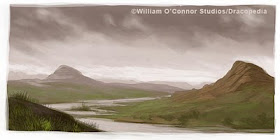 St. Margaret and the Dragon
St. Margaret and the Dragon
William O'Connor ©2009
When we think of dragon slayers we always imagine brave strong knights in shining armor riding their chargers with lance in hand slaying a horrible dragon and rescuing a maiden in distress. St. George is a perfect example. Beowulf and the army of the 12 Lords, The Redcrosse Knight of Spencer's Fairie Queene is another, doing battle with a titanic 600' long flaming flying beast for three days. King Seigfried kills Fafnir and of course, as I'm sure we are all anticipating being brought to life in vivid digital 3-D CGI, Bard of Esgoroth who slays Smaug in The Hobbit.
There is however a great dragon slayer who tends to go overlooked, a 15 year old shepherdess girl who slays a dragon single handedly with nothing more than an iron cross from around her neck.
St. Margaret is an amazing story, and one that I had only very briefly mentioned in my book Dracopedia, and had gone mostly unnoticed in my research until I moved into St. Margaret's Parrish in Pearl River , NY. On the first day attending church in our new home there above the alter in vivid stained glass was St. Margaret standing on a dragon. Thinking this serendipitous, I began to do some research and became very impressed with this young lady!
Starting life as the daughter of a powerful 5th Century Roman priest, she converts to Christianity and refuses to marry and denounce her faith. She is cruelly tortured and (stories vary here), she becomes a shepardess living in the country. Here she encounters a dragon who swallows her whole. Some stories suggest that it is Satan in the form of a dragon, but the imagery and metaphor is still poignant. A young teenage girl tortured and violated by the minions of her own father is then devoured by a dragon. Instead of surrendering, instead of giving up, she fights back, and cuts and hacks her way out of the dragon with her iron cross. Eventually however she is put to death instead of renouncing her religion. (That is a really tough girl!!) She shows up again briefly as one of the Saints that appears to Joan of Arc.
The sketch above is a design I developed of St. Margaret and the Dragon, with the intention of finishing a full painting. (Do Churches still commission Alter pieces?) It recently was included in
"Sketchbook Confidential" put out by Northlight Books, where I've included several of my dragon drawings and talk about my process. Below I've attached a few art history examples of Margaret and her encounter with the dragon.
Enjoy and Good Dragon Hunting!
WOC




To view a selection from the book or purchase
Dracopedia visit:
Amazon.com/Dracopedia©2010William O'Connor/William O'Connor Studios/Dracopedia:A Guide to Drawing the Dragons of the World/The Dracopedia Project. All rights reserved.
 I'm currently working on a new private commission of the Redcrosse Knight and the Dragon. As the digital sketch develops I will transition to a traditional oil medium. Still working on the design. It is also the subject of my new video sketch evolution on YouTube
I'm currently working on a new private commission of the Redcrosse Knight and the Dragon. As the digital sketch develops I will transition to a traditional oil medium. Still working on the design. It is also the subject of my new video sketch evolution on YouTube
 To view a selection from the book or purchase Dracopedia visit:
To view a selection from the book or purchase Dracopedia visit:
































